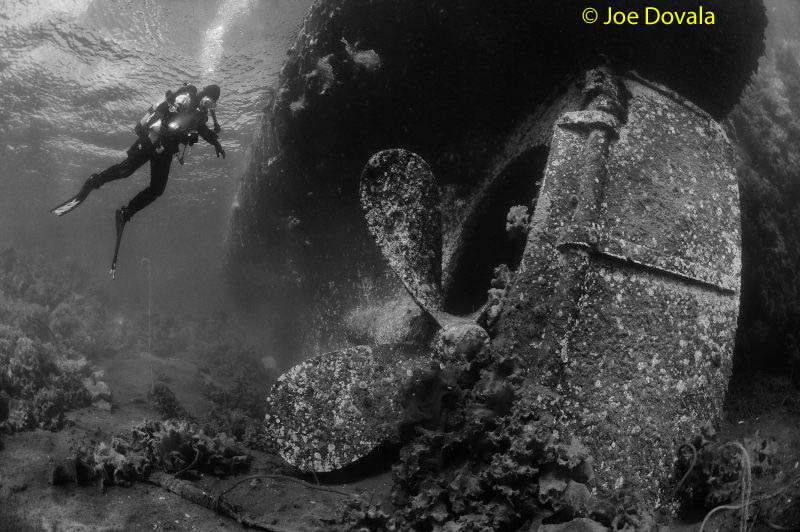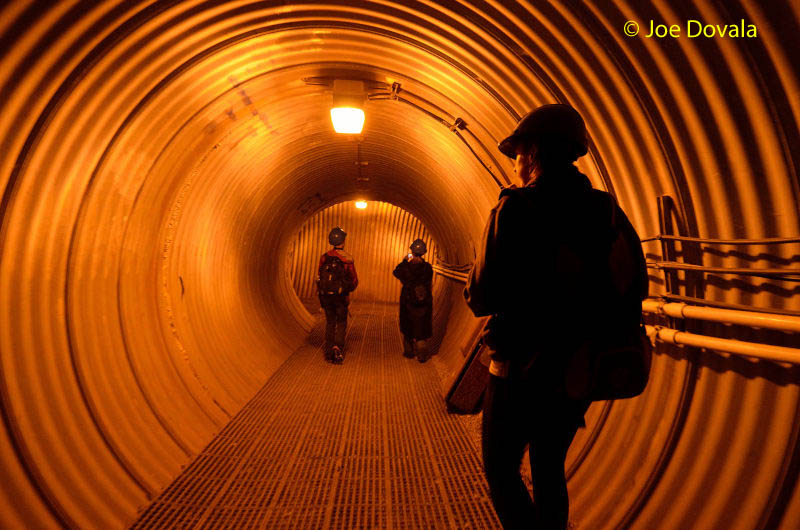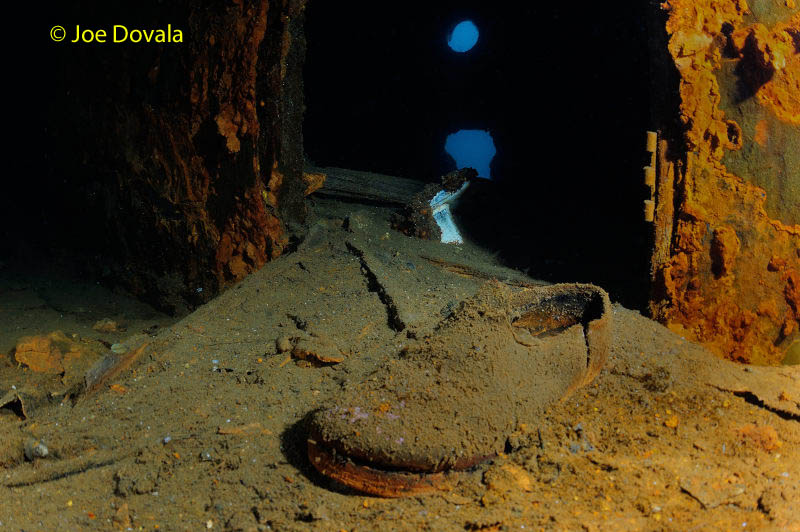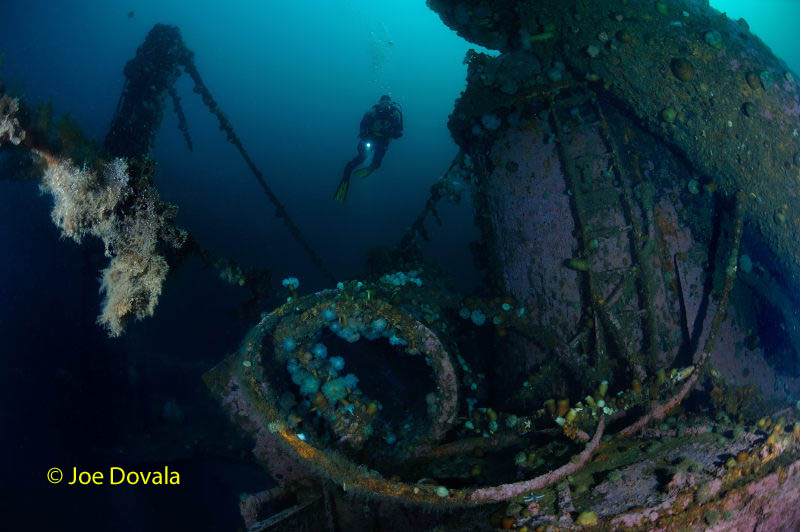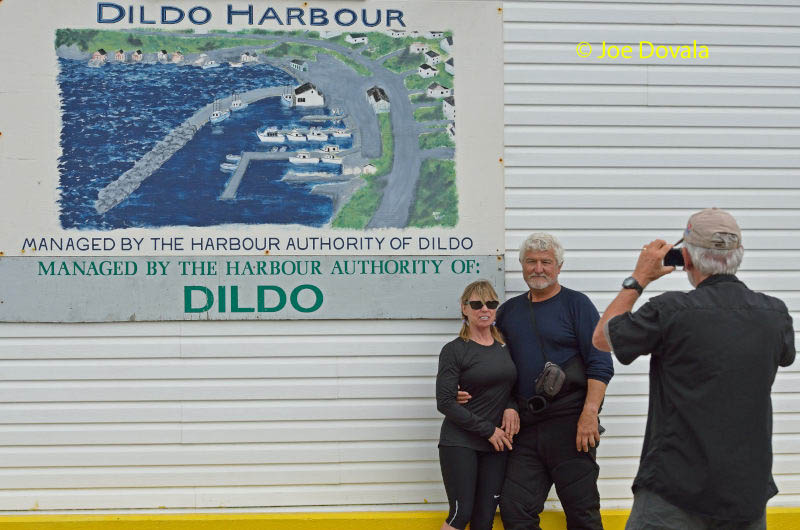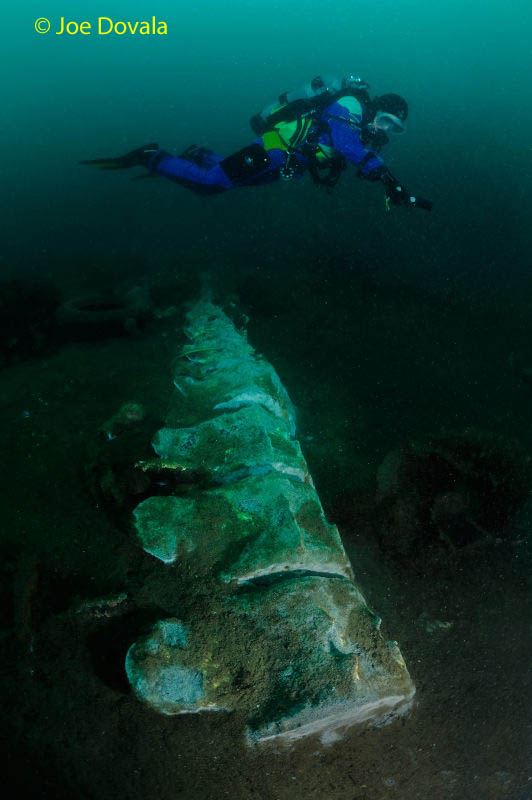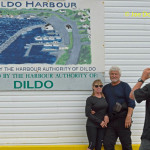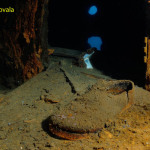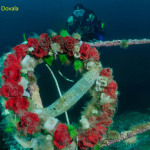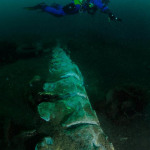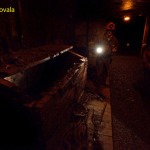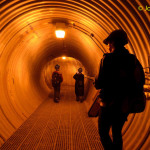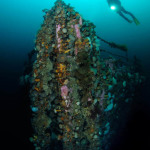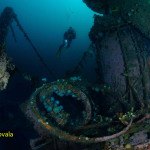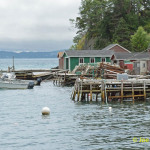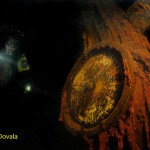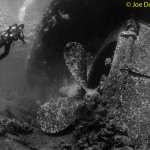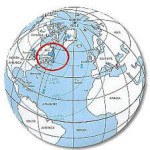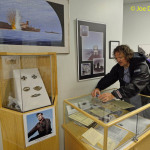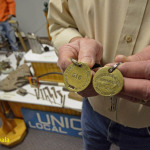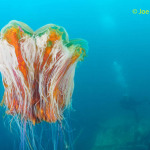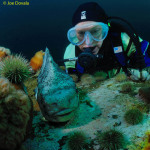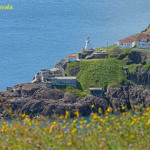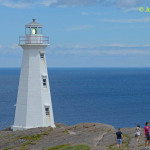“You’re going where? What’s there?” And so it went, from one person to another, no one could understand why we wanted to dive in Newfoundland. After all, you can’t really blame them, the RMS Titanic lies a mere 350 miles away and everyone knows what sank her. Finding cold water here is as easy as finding sand in the desert. But we found something else too; in fact, a whole bunch of something else. Newfoundland (spoken as New.fun.land) along with the peninsula of Labrador, make up the eastern most Province of Canada. Newfoundland is an island of over 42,000 square miles. With a land mass of nearly the size of Southern California, and only 480,000 people, there’s no problem finding space to stretch the eyes.
Story and photos by Joe Dovala, Dovala Images
The first human inhabitants were likely Paleo-Eskimos followed by a people called the Dorset. By the time of the first Norsemen, Leif Eriksson in the late 10th century, the Dorset appeared to be already gone. Eriksson named the “new land” Vinland. After the Vikings showed up, a group of people known as the Beothuk arrived from Labrador. The Vikings didn’t keep a permanent settlement so the new locals had the place pretty much to themselves for some 500 years. In 1497 John Cabot, under contract to England’s King George VII, landed and claimed the landfall for the British Empire. Of course, many other European visitors came as well including the Portuguese, Spanish, and French. By 1583, Newfoundland was named Britain’s first overseas colony in the New World. Squabbles continued but by the late 18th century permanent settlements largely of English, Irish, and some French sealed the melting pot of Newfoundland.
Some mining engineers in the early 1890’s noticed that the subsurface geology of Bell Island was rich in red hematite, and by 1894 the Bell Island Iron Ore Mine of Conception Bay began. For over 70 years men and horses scratched, dug, and blew up the rich ore deposits formed countless eons ago. The entire mine is underground and extends for miles out under the bay. By the beginning of WWII Bell Island iron had found its way all over the world. Since steel is a major requirement to build war machines this mine took on even more importance. That fact didn’t escape the notice of Nazi Germany. In late 1942, U-Boats struck and sent 4 large iron ore carriers, and their crews, to the sea bed of Conception Bay – more on this later. However, the mine continued to supply much needed raw materials for the remainder of the war. In 1949, the former British Colony of Newfoundland joined the Confederation of Canada.
The rich fishing grounds were the original big draw for the settlers through the years. Cod, crabs, and whales formed the backbone of this “industry.” By the early 1970’s the whaling stopped and in the early 90’s the cod fisheries collapsed from over-fishing. Despite a long moratorium on commercial cod fishing the fish have not returned to anything like their former numbers. Since the 1980’s large offshore oil fields and western oil shales have been increasing the flow of petroleum out of Canada, making the Canadians 6th in the world for oil exporting. The city of St John’s is the hub for this black gold wealth in Newfoundland. The economy is booming and it shows in new highway, housing, and other commercial construction projects. In other words, if you expected that Newfoundlanders lived in igloos and got around by dog sleds, you’d be quite disappointed.
Though we arrived at St John’s International Airport at night it was obvious that the facilities were newer and well thought out. Customs was Canadian efficiency with a smile. The 30 minute drive down the newer Trans-Canadian Highway was smooth and uneventful. For this trip we were going to be exploring Conception Bay and the shipwrecks of Bell Island, so our base camp would be in South Conception Bay.
The boat rides on Conception Bay are a real treat. The surface mostly looked like a mirror and even when the wind kicked up the protected expanse of water never got too rough. The water temperature, on the other hand, was more of a trick. Even though we had 70’s and 80’s for air temps, the water profile pretty much stayed the same for our week. From surface to around 15 feet the temp hovered around the mid 50’s – not too bad. Down to 60 -70 feet, mid to upper 40’s ruled. Below 100 feet you were in the 30’s. Yes, it’s cold; but these low temperatures not only provide a unique thriving eco-system but have preserved the sunken ships as well.
The four shipwrecks are definitely the signature dive sites and their remarkable preservation is not something to miss. Despite some heavy damage that you’d expect from vessels sunk in war, much of the ship’s equipment, brick-a-brack, and even sailors personal effects still exist in place. One reason they’re so well preserved is; you guessed it, the less than warm water that bathes them.
Our first dive was the S. S. Paris-Lyon-Marseilles, or PLM-27. She’s the shallowest and is smothered in marine life. Her prop and rudder are undamaged along with most of the stern. It was here that we encountered our first lumpfish and we all fell in love with the odd critter. It seems to be part frog fish and part puffer rolled into one, with an amazing sucker on its “belly” for hanging out. The PLM-27 was one of the ships lost on the second attack in November, 1942. She sank in less than a minute with 12 crew still aboard.
Dive two brought us to the S.S Saganaga. A little deeper at 115 feet to the bottom, the Saganaga went down in the September attack with 29 men. She is even more coated with marine life, including vast numbers of metridium anemeones, crabs, fishes, and colorful sponges. This ship also has the most deck swim-throughs which make for a very three-dimensional experience without penetrating.
The S. S. Lord Strathcona and S.S. Rose Castle are both located in slightly deeper water but consequently are more intact. If you have the training and experience the Rose Castle provides almost limitless potential for penetration. The Strathcona is the only ship which did not suffer any casualties as all managed to abandon ship before the torpedo struck. The Rose Castle lost 28 sailors. One of the amazing things to see on these ships is the quantity of wood that is still in place, even unharmed hatches. These vessels have been down longer than the Chuuk Atoll wrecks but are in much better condition. Besides the cold temperatures pillaging has been kept to a minimal, because of respect for these gravesites, low relative amount of divers, and efforts by the local dive operators.
We also made a “beach” dive on a few scuttled old whalers. The SS Sukha, SS Charcot, and SS Southern Foam. Basically you suited up on a picnic table and then walked into the wave-less bay where the Southern Foam still sits significantly out of the water. This is a dive not to be missed complete with propeller and harpoon gun. During the summer the wrecks are covered in a green blanket of algae which adds to the mystery of these ships. Much sea life makes their homes here, and since the vessels are somewhat stacked together they make a very interesting afternoon sortie. The whalers probably were scuttled during an attempt at recovering some insurance money, as the whaling times were just about over when they were abandoned in 1964.
Sunken ships are not the only game in town for water people. Though we didn’t have time to visit any reef systems, there’s little doubt you’d find opportunity here as well. Standing on cliffs during hikes it was easy to look down into the clear water and see thriving rock reef communities. One of the most popular outings is to head up to the quaint seaside village of Petty Harbor for some whale action.
Humpback whales can be numerous and playful, especially July through August. Also, beluga, minke, and even narwhals have been seen at various times of the summer dive season. Admittedly, humpbacks are by far the most numerous and likely to play with snorkelers; most of the time you’ll see the oversized white pectoral fins glowing first in the distance. Watching a 45 foot humpback materialize out of the murk and slowly cruise by while watching you with her large eyes is quite a thrill. In another town named Dildo (yes, true name), a quite different whale encounter can be had. For decades until the early 1970’s, just off shore within the township, the carcasses of hundreds of whales were unceremoniously dumped. The eerie shore dive is now a protected area so you can visit the whale bone grave yard. A very poignant reminder of a not so distant past.
With 6000 miles of coastline and almost 3000 feet of elevation the outdoor options for things to do are almost limitless. The island has many topside opportunities, ranging from sea kayaking, camping, fishing, hiking, and sightseeing. There’s even a ski resort (Marble Mountain) if you’re visiting in winter. The International Appalachian Trail is being extended along the island’s mountainous west coast. On the east coast, the East Coast Trail extends through the Avalon Peninsula for 220 km (140 mi), beginning near Fort Amherst in St. John’s and ending in Cappahayden, with an additional 320 km (200 mi) of trail under construction.
A visit to Bell Island is a must. Besides the car ferry ride over and bucolic beauty of the island, the museum and tour facility of the aforementioned Bell Island Iron Ore Mine is out of the ordinary. The museum is well appointed with lots of docents to answer questions and tell great stories. Taking a tour deep into the underground mine gives you more than a little admiration for the men, and horses that worked for years in damp darkness. The size of the subterranean digs is mind boggling and the fantastic facts and real life stories you’ll get on the guided tour are priceless. For more citified action, George Street in St. John’s is closed 20 hours a day to vehicle traffic, and is said to have more pubs per square meter than anywhere in North America. A wide variety of restaurants offer just about any kind of cuisine you could ask for including some very Newfoundland fares like cod tongue and “figgy duff” (16th century pudding).
Our entire group was more than pleasantly surprised by what we found in Newfoundland. The best of both worlds seem to mingle here: You can easily find the night life in the city or the charm of small rustic seaside villages within a few miles of each other. Most are connected by very good roads and minimal traffic. The people are warm and friendly being eager to help you with directions, recommending a good place to eat, or even suggest a good place to “dipsy doodle.”
Newfoundland Facts and Figures
Climate: Average day air temperature in the warm season (late June – mid September) is in the 60’s but can reach into the 80’s. Cold season (early December – late March) usually in the 30’s to 40’s – nights of course colder. Water temperature during warm season averages mid 50’s on surface, mid 40’s to 60 feet, and below 100 feet in the high to low 30’s. Visibility ranges from 40 to well over 100 feet. Winds can kick up at anytime
Power: Same as United States; 110V no special plugs or attachments needed.
Money: Canadian Dollar (CAD). U.S. money readily accepted but you will most likely get CAD back in change. Currently 1.00 USD = 1.03 CAD.
Tipping: At restaurants 10 – 15% is considered the norm with some larger bills having the tip already included. Of course, tipping should be based on quality of service and not automatic. Same as U.S.
Time: PST + 4.5hrs. For example: 9AM in Los Angeles would be 1:30PM in St. John’s.
Getting There: St John’s is the point of entry for international visitors. Direct flights are few and mainly from the Northeast United States. West Coast travelers will spend most of a day getting here. A small number of airlines service Newfoundland, including United Airlines and Air Canada.
Entry Requirements: Valid passport is required.
General Health: Same as U.S. or better.
General Safety: Crime is lower per capita in Newfoundland but some caution and “common sense” should be used especially in cities.
Recompression Chamber: Closest is in St. John’s.
Dive Operators
South Conception Bay
Ocean Quest Adventures
sales@oceanquestadventures.com
866-623-2664
They have a multitude of custom diving, whale, sightseeing packages available as well as full accommodations in a Bed & Breakfast style.
St John’s
Dive Adventures
524 Water Street
April 1 – Nov 30
+1 (709) 754-8687
Equipment rentals, dive certification, additional attractions/activities
Photo Gallery (Click to enlarge any of the images below):
- Yes, it’s a real town.
- A shoe found on the Wreck of PLM 27
- Wreath to lost sailors
- Whale vertibrae
- Underground horse stables
- Staring mine tour
- SS Saganaga bow
- Diving on the SS Rose Castle (Click to enlarge)
- Small fishing village
- The telegraph in the engine room of the Rose Castle (Click to enlarge)
- People are very friendly here
- Old whaler
- Museum display of U-513
- Mine worker ID medallions
- Lions mane jelly
- Female lump fish
- Entrance to Saint Johns Harbor
- Cape Spear lighthouse

